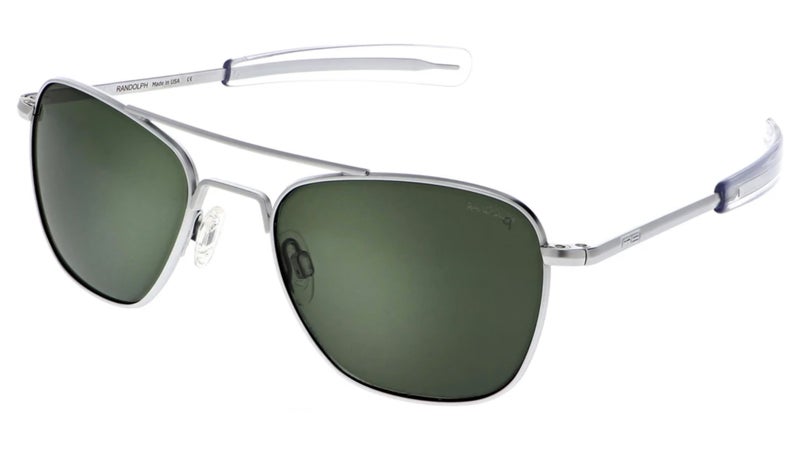Turn on virtually any movie made in the past four decades with American military characters in it, and youÔÇÖre going to see actors wearing timelessly stylish, metal-framed sunglasses with distinctive straight temple tips. Many of┬áthose are made by , and the talent is wearing them for two reasons: theyÔÇÖre the real deal, and theyÔÇÖre┬áperfect. IÔÇÖve been wearing mine since December.
Based just south of Boston, Randolph Engineering is a small, family-owned company thatÔÇÖs been making eyewear in the U.S.┬ásince 1973. It was awarded its first military contract in 1978┬áand still produces glasses adherent to the militaryÔÇÖs 20-page-long technical requirements, for both Department of Defense and civilian customers.
That means these aviators are made using a six-week, 200-step process thatÔÇÖs completed 80 percent by hand. Only one stepÔÇöelectroplating the frames to give them a durable finishÔÇötakes place outside of RandolphÔÇÖs own facility.
You might expect such an exhaustive pursuit of quality to warrant┬áa very high price tag, and while these arenÔÇÖt of the cheap gas-station variety,┬á, only a few bucks more than foreign-made competition from the various Luxottica brands. The value proposition is boosted by a lifetime warranty for frame joints, a two-year warranty for all other defects, and an in-house, mail-in repair service for anything else, starting┬áat $25.
Randolph spent the past decade attempting to pivot its business away from the boom-and-bust cycle of military contracts toward the more predictable consumer market, but it does still make eyewear for all branches of the armed forces. Today it offers styles beyond its original aviator, in a wide variety of finishes that go well beyond the classic chrome.
I wear a 55-millimeter┬áaviator with a┬ábright chrome frame┬áand polarized, green-tinted glass lenses, options that take┬áthe total price up to $279. The green tint cuts blue light, reduces glare, and aids contrast. Polarization is a chemical laminate applied to lenses in a vertical pattern, designed to help reduce reflections coming off horizontal surfaces, like water and snow. These┬álenses only allow 10┬ápercent of light through, making them more suitable in very bright conditions than the 15 percent thatÔÇÖs more typical from aviator-style glasses. TheyÔÇÖre also shatterproof┬áand polished to the same clarity standards as a camera lens.

Randolph employs┬áa unique bayonet┬átemple that eliminates the traditional hooked earpiece. The glasses squeeze your head to remain on, rather than resting on your ears. I find this arrangement more comfortable. Designed to be compatible with helmets, the bayonet temples easily slide on and off through the viewport of┬áa motorcycle helmet. That lack of a hook also eliminates a pressure point thatÔÇÖs always bothered me while trying to wear other glasses under helmets.
Aside from the classic, understated look┬áthat makes these shades go well with anything from a tux to a T-shirt, and their comfort, the thing that makes RandolphÔÇÖs aviators so good is the vision they deliver. As anyone whoÔÇÖs ever looked through a really expensive set of binoculars knows, the difference between low- and high-quality glass is astonishing. The view through these things is just as good as it is through its┬árivals IÔÇÖve tried that cost three times as much, and itÔÇÖs vastly better than anything IÔÇÖve experienced from mainstream brands.
All this adds up to a pair of glasses that look┬áso┬áclassy, I wore them at my wedding,┬áon the 5,000-mile drive down to Baja Sur, MexicoÔÇöwhere I married my wifeÔÇöand back, and virtually every day since. Their extreme clarity improves my ability to drive safely by helping me identify potential obstacles at a greater distance in bright light than naked eyes alone could. For sportswear, theyÔÇÖre not quite stable enough to wear on a mountain bike, and I add a leash to them when donning┬áthem on the water, but they will stay in place through slower-paced activities, like hiking or resort skiing. While fishing, the polarization eliminates the most water-surface reflection of any glasses IÔÇÖve tried.
Now that IÔÇÖm so familiar with these aviators, watching┬áTV has gained┬ánew entertainment as well: Randolph spotting. One night during the height of the COVID-19 shutdown, I counted these exact same sunglasses in three separate action movies. And now I know why theyÔÇÖre so ubiquitous on-screen.


